
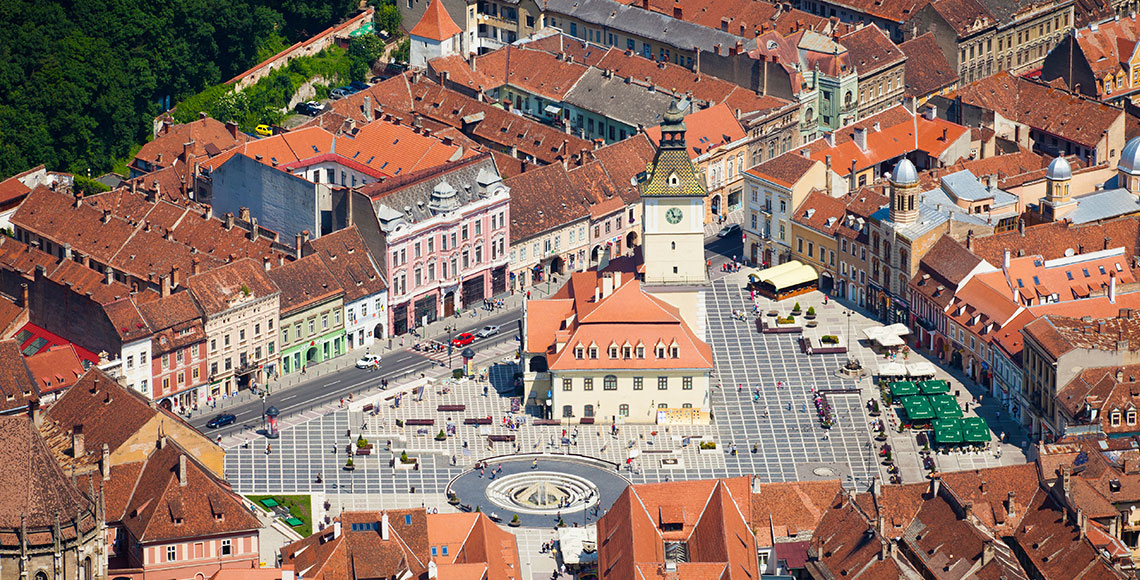


You have good reasons to choose Romania as your next business and leisure destination:
We design unique business and leisure experiences for you in Romania. We provide creative ideas and dependable support for incentive trips, handled by professionals who are intimately familiar with our destination – Romania. We work hand-in-hand with the client to create that unique and magical Romania experience that your groups will never forget.
Our primary commitment is to provide specialized, sophisticated and customer-oriented services. We are available to the client before, during and after the execution of the program.
Our service is based on step by step assistance, planning, budget efficiency, creativity, attention to detail, flexibility and enthusiasm.
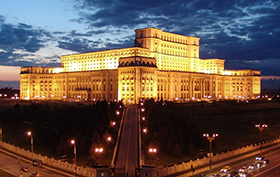
Being over 550 years old, Bucharest went through a series of continuous changes, representing the central scene of Romania’s political, artistic, university, financial and cultural life. Between both world wars, due to the elegant architecture and the elite living here, the city was nicknamed “The Little Paris”.
Bucharest Sightseeing tour will start in the morning at your hotel and following a four hour itinerary will show the participants the most interesting sights of Bucharest downtown with entrance at the Parliament Palace (optional) and The Village Museum (optional).
Free Press Square (Piata Presei Libere) – The Arch of Triumph (Arcul de Triumf) – Victoriei Square (Piata Victoriei) – Calea Victoriei – Revolution Square (Romanian Atheneum, Revolution’s Memorial) – The Palace of Parliament (Palatul Parlamentului) – Union Square (Piata Unirii) – University Square (Piata Universitatii) – Romana Square (Piata Romana) – Victoriei Square (Piata Victoriei) – Charles de Gaulle Square (Piata Charles de Gaulle) – The Village Museum (Muzeul Satului).

The Village Museum was established in 1936 and it contains over 300 wooden houses, windmills, churches etc. from all over the country. You shouldn't miss this museum which is one of the largest of its kind in Europe. Many of the buildings are originals which were brought here in pieces and reassembled. The oldest houses date as far back as the 17C. Behind the project from the start was ethnographer Dimitrie Gusti (1880 - 1955) who wanted the museum to mirror as closely as possible the aspects of the rural life. Because of this the museum is organized as a real village, with clusters of houses being linked by winding paths. This makes for a pleasant stroll especially if you find yourself in Bucharest during the summer, when the city is hot and dusty. Sometimes the museum hosts crafts fairs and folk music and dance festivals.

Built at the special request of Nicolae Ceausescu, leader of Romania's Communist Party, the colossal Parliament Palace- formerly known as "People's House" ( Casa Poporului ) -is the world's second largest administrative building after the U. S. Pentagon. Built, furnished and decorated exclusively with materials sourced and made in Romania, the building reflects the work of the country's best artisans. A guided tour takes visitors through a small section of dazzling rooms, huge halls and quarters used by the Senate (when not in session). The interior is a luxurious display of crystal chandeliers, mosaics, oak paneling, marble, gold leaf, stained-glass windows and floors covered in rich carpets.

Being over 550 years old, Bucharest went through a series of continuous changes, representing the central scene of Romania’s political, artistic, university, financial and cultural life. Between both world wars, due to the elegant architecture and the elite living here, the city was nicknamed “The Little Paris”.
The program will start in the morning with pick-up from your hotel and a panoramic drive through the city with brief stops for photos and explanations. In the second part, you will enjoy a 45-minute walking tour of the old downtown area.
Free Press Square (Piata Presei Libere) – The Arch of Triumph (Arcul de Triumf) – Victoriei Square (Piata Victoriei) – Calea Victoriei – Revolution Square (Romanian Atheneum, Royal Palace, Revolution’s Memorial) – Bd. Elisabeta – Opera Square – Bd. Eroilor Sanitari– Cotroceni Palace – The Military Academy – The Palace of Parliament Union Avenue – Patriarchate Church- Union Square (Piata Unirii) – University Square (Piata Universitatii) – Roman Square (Piata Romana) – Victoriei Square – Bd. Aviatorilor – Charles de Gaulle Square (Piata Charles de Gaulle - The Arch of Triumph – Free Press Square. The Walking Tour will show historical buildings as: C.E.C. Palace (Palatul C.E.C.) – The National Museum of History Palace (Palatul Muzeului National de Istorie) – The building of Carul cu Bere restaurant (Restaurantul Carul cu Bere) – The Palace of National Bank (Banca Nationala a Romaniei) – Stavropoleos Church (Biserica Stavropoleos) The Old Royal Court (former residence of Vlad The Impaler and other rulers of Wallachia) – Saint Anton Church (the oldest church in Bucharest preserved in the original shape) – The building of Manuc Inn (Hanul lui Manuc).
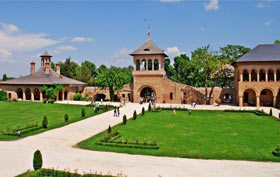
This 4-hour tour includes an introductory panoramic tour of Bucharest with brief stops for photos and explanations, followed by a trip outside Bucharest to Mogosoaia Palace located 20 km north of the city.
The itinerary will include: Free Press Square (Piata Presei Libere) – The Arch of Triumph (Arcul de Triumf) – Victoriei Square (Piata Victoriei) – Calea Victoriei – Revolution Square (Romanian Atheneum, Revolution’s Memorial) – The Palace of Parliament (Palatul Parlamentului) – Union Square (Piata Unirii) – University Square (Piata Universitatii) – Romana Square (Piata Romana) – Victoriei Square (Piata Victoriei) – Charles de Gaulle Square (Piata Charles de Gaulle) – The Village Museum (Muzeul Satului). Then, head to Mogosoaia to visit the Palace.
After about one hour of driving to the north of Bucharest we will reach Mogosoaia Palace, a monumental building having a unique architecture called Brancovenesc Architecture, which is Romanian Renaissance architectural style having a mixture of Venetian and Ottoman elements. The Palace was built by the ruler Constantin Brancoveanu in 1702. After the execution of Constantin Brancoveanu in Constantinopol in 1714, the palace continue to be own by the family, but has passed a decline during the Ottoman rule period. It was renovated starting with 1912 by Martha Bibescu becoming a meeting place for the members in the high level society. During the Second World War, the palace was also a meeting place for the Allied diplomats. In the end of the Second World War, after 1945, the palace was nationalized by the Communist Party. In the present, the palace hosts the Museum of Brancoveanu Art and it is an important tourist attraction.
Mogosoaia Palace is closed on Mondays and you will see it from outside.
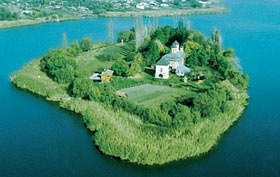
This 4-hour tour includes an introductory panoramic tour of Bucharest with brief stops for photos and explanations, followed by a trip outside of Bucharest to Snagov Monastery located 30 km north of the city.
The itinerary will include: Free Press Square (Piata Presei Libere) – The Arch of Triumph (Arcul de Triumf) – Victoriei Square (Piata Victoriei) – Calea Victoriei – Revolution Square (Romanian Atheneum, Revolution’s Memorial) – The Palace of Parliament (Palatul Parlamentului) – Union Square (Piata Unirii) – University Square (Piata Universitatii) – Romana Square (Piata Romana) – Victoriei Square (Piata Victoriei) – Charles de Gaulle Square (Piata Charles de Gaulle) – The Village Museum (Muzeul Satului).
Then, head to Snagov to visit Snagov Monastery.
Snagov Monastery is located on an island in the northern part of Snagov Lake. The monastery was built by Mircea the Elder (the grandfather of the famous Dracula) who made also the first documentary attestation of this church in 1408. During its history, the monastery was rebuilt by Vlad the Impaler and some other rulers of Wallachia.
It was one of the strongest fortified church and maybe the richest in Wallachia a long time in the Medieval Period. Snagov Monastery was also an important cultural center, running here one of the first printing house of Wallachia. Snagov Monastery is one of the most popular tourist destination especially for the foreign tourists coming in Bucharest.
Please note that the time table is subject to changes due to heavy city traffic and road works.
The surroundings of Bucharest represent a very pleasant destination highly appreciated by the locals and tourists, as well. Mogosoaia Palace, located in a beautiful and peaceful natural park, impresses its visitors thanks to its unique genuine Romanian architectural style, known as Brancovenesc style. Find out the tumultuous story of the palace and the one of the people who lived here over the past centuries.
Do not miss Snagov Monastery, which became so famous thanks to the Legend of Dracula as, according to local stories, it is believed that in the monastery, Vlad the Impaler has his grave and the beautiful Caldarusani Monastery, one of the oldest and largest Orthodox Monasteries in Wallachia.

Snagov Monastery is located on an island in the northern part of Snagov Lake. The monastery was built by Mircea the Elder (the grandfather of the famous Dracula) who made also the first documentary attestation of this church in 1408. During its history, the monastery was rebuilt by Vlad the Impaler and some other rulers of Wallachia.
It was one of the strongest fortified church and maybe the richest in Wallachia a long time in the Medieval Period. Snagov Monastery was also an important cultural center, running here one of the first printing house of Wallachia. Snagov Monastery is one of the most popular tourist destination especially for the foreign tourists coming in Bucharest.
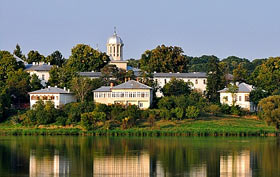
Caldarusani Monastery is located also on the shore of a lake surrounded by a beautiful forest. It was built in the XVIIth century by Matei Basarab and it represents one of the largest and oldest Orthodox Monasteries in Wallachia historical region. The church shelters an impressive collection of religious objects and books. The icons are very beautiful, six of them being painted by the most important Romanian peinture, Nicolae Grigorescu.
After the visit travel to Mogosoaia and admire the beautiful scenery of the forest and the countryside.

After about 45 minutes of driving from Caldarusani Monastery, you will reach Mogosoaia Palace, a monumental building having a unique architecture called Brancovenesc style which is a Romanian Renaissance architectural style consisting of a mixture of Venetian and Ottoman elements.
The Palace was built by the ruler Constantin Brancoveanu in 1702. After the execution of Constantin Brancoveanu in Constantinople in 1714, the palace continues to be own by the family, but it passed a decline during the Ottoman rule period. It was renovated starting with 1912 by Martha Bibescu becoming a meeting place for the members in the high level society. During the Second World War, the palace has been also a meeting place for the Allied diplomats. At the end of the Second World War, after 1945, the palace was nationalized by the Communist Party. In the present, the palace hosts the Museum of Brancoveanu Art and it is an important tourist attraction.
After the visit to Mogosoaia Palace we head to back to Bucharest.
Drop off at your hotel in Bucharest.
Mogosoaia Palace is closed on Mondays and you will see the palace from outside.
Please note that the time table is subject to changes due to heavy city traffic and road works.
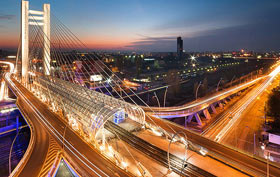
Being over 550 years old, Bucharest went through a series of continuous changes, representing the central scene of Romania’s political, artistic, university, financial and cultural life. Between both world wars, due to the elegant architecture and the elite living here, the city was nicknamed “The Little Paris.”
The tour will start from your hotel and following a seven hour itinerary will show the participants the most interesting sights of Bucharest downtown with entrance at the Parliament Palace (optional – open between 10 am – 3 pm), Cotroceni Palace (optional – open between 10 am – 3 pm) and The Village Museum (optional – open between 10 am – 4 pm). On the road we will stop for a lunch (optional) in a local restaurant.
The itinerary depends on your hotel’s location, but it will include: Free Press Square (Piata Presei Libere) – The Arch of Triumph (Arcul de Triumf) – Victoriei Square (Piata Victoriei) – Calea Victoriei – Cotroceni Palace (Muzeul Cotroceni) – Revolution Square (Romanian Atheneum, Revolution’s Memorial) – The Palace of Parliament (Palatul Parlamentului) – Union Square (Piata Unirii) – University Square (Piata Universitatii) – Romana Square (Piata Romana) – Victoriei Square – Charles de Gaulle Square (Piata Charles de Gaulle) – The Village Museum (Muzeul Satului).

The Village Museum was established in 1936 and it contains over 300 wooden houses, windmills, churches etc. from all over the country. You shouldn't miss this museum which is one of the largest of its kind in Europe. Many of the buildings are originals which were brought here in pieces and reassembled. The oldest houses date as far back as the 17C. Behind the project from the start was ethnographer Dimitrie Gusti (1880 - 1955) who wanted the museum to mirror as closely as possible the aspects of the rural life. Because of this the museum is organized as a real village, with clusters of houses being linked by winding paths. This makes for a pleasant stroll especially if you find yourself in Bucharest during the summer, when the city is hot and dusty. Sometimes the museum hosts crafts fairs and folk music and dance festivals.

Built at the special request of Nicolae Ceausescu, leader of Romania's Communist Party, the colossal Parliament Palace- formerly known as "People's House" ( Casa Poporului ) -is the world's second largest administrative building after the U. S. Pentagon.
Built, furnished and decorated exclusively with materials sourced and made in Romania, the building reflects the work of the country's best artisans. A guided tour takes visitors through a small section of dazzling rooms, huge halls and quarters used by the Senate (when not in session). The interior is a luxurious display of crystal chandeliers, mosaics, oak paneling, marble, gold leaf, stained-glass windows and floors covered in rich carpets.
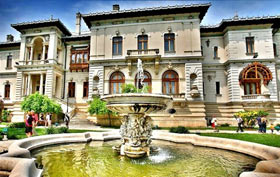
A former royal residence built between 1679 and 1681 by Prince and ruler Serban Cantacuzino, the palace was home to King Carol I, who made important changes in its architecture. At the end of the 19th century, Heir-to-the-Crown Ferdinand ordered the partial demolition of the palace, which was later reconstructed by French architect Paul Gottereau in neoclassical style. In 1977, Nicolae Ceausescu transformed it into an official guesthouse with the addition of a new wing.
After 1990, the old wing of the palace became a museum. The Oriental Hall, the Norwegian Hall and the Queen's Chamber are almost unchanged from the original design and are worth visiting. Very important collection of medieval art also can be seen here. The new wing serves as the seat of the Romanian Presidency.
This is a full day tour from Bucharest to Transylvania on a very picturesque route through Carpathian Mountains allowing you to discover two of the most beautiful Romanian castles.
Bucharest – Sinaia: Visit Peles Royal Castle in Sinaia – General Exhibition standard tour 1 hour (on Mondays and Tuesdays during the winter season you will visit Rasnov Citadel in Rasnov).
Sinaia – Bran: Visit Bran Castle (also known as Dracula’s Castle).
Bran – Brasov: Walking tour of Brasov downtown.
Brasov – Bucharest.
In the morning, you will meet the tour guide and the rest of the group at the meeting point.
At 08:00 am leave Bucharest and head to Transylvania.
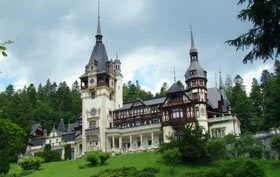
Stop first in Sinaia mountain resort, considered the “Pearl of the Carpathians” and visit Sinaia castle, known as Peles castle. Erected between 1873 and 1914, the monument has been the summer residence of the Romanian Royal family and it is the most visited museum in Romania. You will visit the ground floor exhibition and see the Hall of Honor, The Weapons Room, the Music Room, the Library, the King’s office and many others. At the end of the visit, enjoy some free time in the gardens of the castle and admire the beautiful mountain scenery that surrounds this place.
Continue the day with a scenic drive through the Carpathian Mountains and, in about 1 hour, arrive at Bran where you will visit Bran medieval castle, also known as Dracula’s castle. Dating from the 14th century, it has has been serving for ages as a military fortress controlling the entry route to Transylvania and it is nowadays frequently associated with Dracula’s myth.

Before heading back to Bucharest, we will remain in Transylvania and stop for a short time in Brasov, a typical medieval city. Known as Kronstadt, under its German name, the city was founded in the 13th century by the Saxon community and developed as a trade settlement at the crossroads between Orient and Occident. You will stop in the Council Square and start a short walking tour in the Old Town. You will learn more about the story of the Saxons in Transylvania, admire the impressive and well preserved architecture, see the Black Church (symbolic building of the city – view from outside) and discover which is the second narrowest street in Europe, the Rope Street.

For those not acquainted with our home city, we propose a program that touches both the historical and architectural side of an Eastern European capital that bears the marks of different eras, as well as the modern, vibrant life of a city in continuous renewal.
The easy access by plane, within approximately 2 hours from every important city of Europe, and the 5 stars international hotel chains accommodation will already give you the comfort feeling of your trip. Every night will be a chance for you to delight in fine dining at some of Bucharest’s best traditional restaurants, located in historical places of the city.
We invite you to spend a full day discovering the most interesting places in Bucharest (Parliament House), special collections (museums) and some of our Romanian traditions (Village Museum), in a fun, relaxing way.
Services:
Dates: March – September
No of persons: 15
Included services:

Discover Romania for the first time by taking a walk in the evening in Bucharest and continue the next day to the heart of Transylvania. Do you think it will be enough? We can assure you will come again here, for more. We have so much to share with you from our culture and our way of living.
Bucharest will open up to you with traces of Little Paris in the old city centre, and with the well-known communist building, the Parliament House. We’ll have time to enjoy the best Romanian dishes in old luxury restaurants.
We will then follow Prahova Valley all the way to the heart of Transylvania, passing by Neo-Renaissance castle Peles, the largest Gothic church between Vienna and Istanbul – the Black Church, and the amazing Carpathian Mountains.
You will have fun and enjoy the trips, dip into our history and into the legends of the Romanians…. And you will enjoy the well-preserved nature and good, traditional food.
Services:
Dates: May – September
No of persons: 15
Included services:
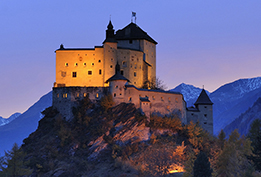
We will take you on the footsteps of Dracula, in the legendary lands of Transylvania, and we will take care of your fears!
After we greet you in Bucharest, we will accommodate and introduce you to the local atmosphere, quite close to Dracula’s Castle, in the Carpathians Mountains.
For the next days, we will untie the legend, following Vlad the Impaler’s birth place in Sighisoara – the unique, inhabited medieval fortress, then we will head to Bistrita for more fun and history, at Dracula Night Show. On the way back, we will stop to the Bran castle, the one that inspired Bram Stoker’s novel along with the life of Vlad the Impaler. Let us entertain you with our fascinating story about this legendary character, the scary Dracula Show, a barbeque in the Carpathian Mountains, and many more!
Services:
Dates: February – September
No of persons: 20
Included services:
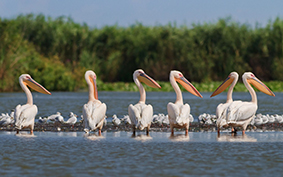
Come with us on a unique trip, to discover the channels, marshes and lakes that will take your breath away. Typical vegetation and fauna, bird colonies that come here in springtime and leave before winter, stunning sunsets and old fashioned fishermen, are among the unexpected beautiful things you will enjoy in the Romanian delta.
Danube Delta offers some of the best ecological stays in Europe and is the only river delta in the world protected as a biosphere reserve, with over 580,000 hectares of preserved wetlands and over 5,000 species of flora and fauna. Danube Delta is a place set apart from the rest of Romania, where life has hardly changed for centuries and where boats are the only way to reach many settlements.
Services:
Dates: May – September
No of persons: 15 - 18
Included services:
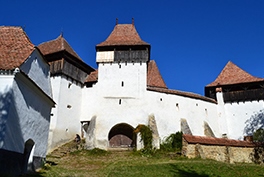
The Medieval Saxon fortress-churches of Romania, also called the Fortresses of Faith, are among the most remarkable buildings of Europe’s Christian heritage.
Rarely visited and little known outside of Romania, they have an intrinsic appeal to all Christians, as we rush through the Third Millennium. “Getting around” is not difficult, but it requires determination and a touch of bravado, as the roads are sometimes hilly. No one is in a hurry in Transylvania and the visitor needs to adapt to this dictum. It is indeed a strange contrast to the frenetic pace of the Western Europe, but therein lays its charm – and challenge!
We will follow the fairy tale fortress-churches lying in the heart of Transylvania, their German medieval architecture, and their five hundred years war with the Occidental and Oriental powers. Today, these villages and churches stand almost empty, protected like pearls by their defensive shells, and waiting for the ones who like to discover their particular charm.
Services:
Dates: March – September
No of persons: 20
Included services:
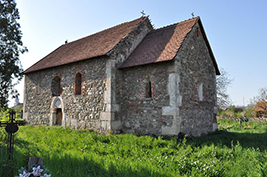
Hateg, one of the richest areas of the country, with a great historical significance awaits for you with some of the most important monuments of architecture and archeology in the country, like the medieval stone churches, Dacian and Roman relics, but also natural monuments. The stone churches from Hateg are the oldest of this type in Romania and among the most interesting monuments of medieval architecture in Transylvania, built between 9th - 12th centuries.
Feel the real adventure in finding the history of the 16 chapels and most of all let yourself captivated by the book of Jules Verne – “The Castle in The Carpathians“. Follow the trails of the novel’s heroes on your way to discover The Colt Castle. A special tour has been prepared for you to visit this area. The itinerary begins in Cluj city and ends at the Colt fortress after a series of “heroic” adventures.
Services:
Dates: all year
No of persons: 10
Included services:
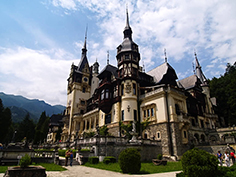
Let’s play and find the party place! We will be in the Carpathians Mountains and will search everywhere for the clues: take photos, write reports, and talk to the local people. On the first night, we will spot Dracula in various moments, looking through the window, running on the corridor…. But we will be leaving for dinner.
In the morning, we will go to another city, Brasov, tracking Dracula, as he seems to pass through that city, too. We will have garlic and everything we need to be protected. Historical sites are visited during the trip, among them the exquisite Peles Castle.
On the next day, our game will continue in the surroundings of the Peles Castle, where we will learn the skills to get inside and guard ourselves in the dark rooms and alleys of the castle… then we will follow the route in the woods, to find Dracula. The Halloween dinner will take place in the mysterious atmosphere of our special Dracula show…
Services:
Dates: around Halloween
No of persons: 40
Included services:
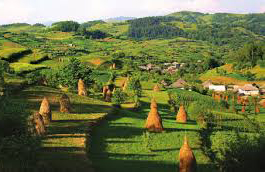
Pedaling through some of the most beautiful Romanian regions. Sharing moments that will stay in our hearts forever. Feeling the breeze in our faces, smiling and keeping active. Join us in a cycling vacation that all keen bike travelers would enjoy: an active holiday that will enrich your experience and will also make you feel healthier and stronger. Our selected hosts are waiting for you with traditional meals and local spirit.
We will take you through the beautiful historical Romanian regions like Maramures, the Danube Delta, Bucovina, Transylvania or Moldova, to discover the magical scenery and off the beaten path villages of Romania. Each day spent in our tours is a new experience in Romania and an occasion to improve your athletic performance, team spirit and cultural and historical knowledge.
Services:
Dates: starting February
No of persons: 15
Included services:

There are a wide array of sports that are played in Romania, and the most popular is football.
If you plan a professional cantonment for your team, we will organize a program which will fulfill all your needs.
Services:
Dates: all year
No of persons: 40
Included services:
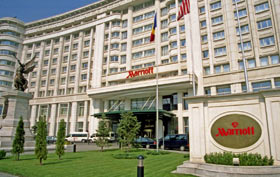
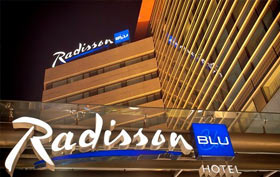

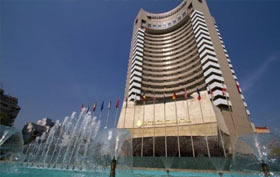
Welcome cocktail and Business meetings – Fortuna Ballroom
Gala dinner – Ronda Ballroom
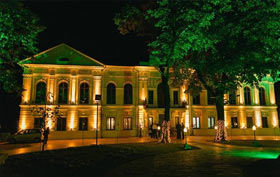


© Copyright 1999 - Accent Travel & Events. All rights reserved.
Tourism licence no. 354 / 18.12.2018 | Assurance Policy no. 58140 (until 15.11.2024) | ANPC Romania |
Build by Lemar Artwork
